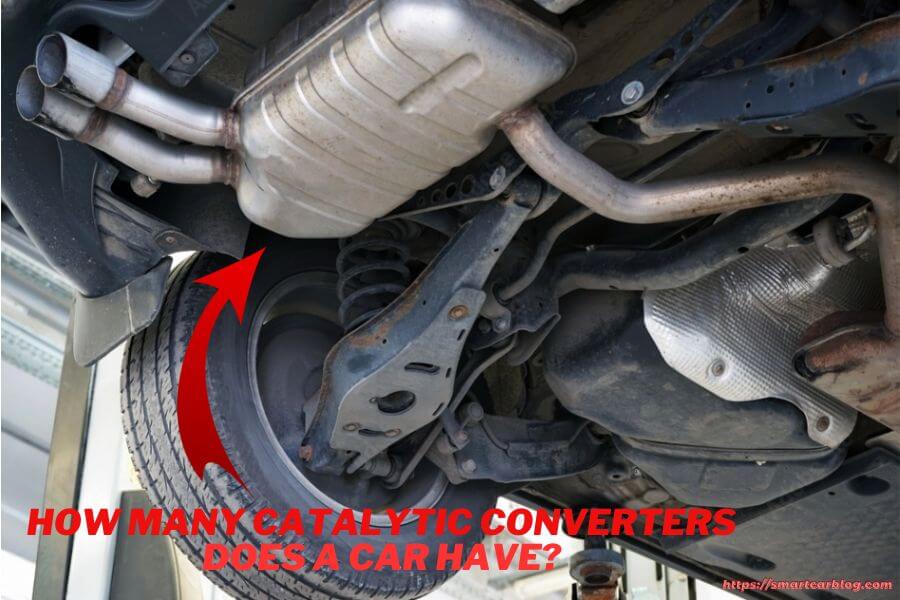Let’s drive into the world of catalytic converters in cars. You see, these nifty gadgets have a crucial job in your vehicle’s exhaust system – they’re like the clean-up crew, ensuring that the harmful emissions your engine produces are turned into less harmful substances before they hit the air. The big question is, “How many catalytic converters does a car have?”
It’s a bit of a jumbled assortment, to be honest. Some cars are content with just one catalytic converter doing all the heavy lifting. But then, those fancier rides or larger engines might boast two or more converters to really nail down those emissions. It’s like having one flashlight versus a whole bunch to light up a room – different situations call for different approaches. So, as we journey into the realm of catalytic converters, we’ll unravel why some cars have more of these pollution-busting champs than others.
Table of Contents
ToggleWhat is a Catalytic Converter?
A catalytic converter, a small but mighty device nestled within a vehicle’s exhaust system, serves a pivotal role in our collective effort to combat air pollution and reduce the environmental footprint of automobiles. Its primary function revolves around transforming the toxic cocktail of emissions expelled during fuel combustion into less harmful compounds. These unassuming champions of emissions control contain precious metals like platinum and palladium, which act as catalysts to accelerate chemical reactions. They convert carbon monoxide (CO), hydrocarbons (HC), and nitrogen oxides (NOx) – the culprits behind smog, acid rain, and respiratory issues – into carbon dioxide (CO2), water (H2O), nitrogen gas (N2), and oxygen (O2), rendering them less harmful to the environment.
The importance of catalytic converters cannot be overstated. With the alarming rise in global pollution levels, these devices have become essential in our pursuit of cleaner air and a healthier planet. They are our first defence against the harmful gases that would otherwise choke our cities and damage them.
The Role of Catalytic Converters
The role of catalytic converters extends beyond just curbing harmful emissions. They also contribute significantly to the overall fuel efficiency of vehicles. By facilitating cleaner combustion, they help engines operate more efficiently, ultimately saving fuel and reducing the carbon footprint of transportation. Additionally, catalytic converters have become essential in meeting stringent emission standards set by governments worldwide. These standards promote cleaner air and drive innovation in catalytic converter technology, leading to more efficient and eco-friendly designs.
In the broader context, catalytic converters are a testament to the engineering marvels that enable us to balance personal mobility and environmental responsibility. As we continue to explore alternative energy sources and electric vehicles, catalytic converters remain indispensable in the transition toward a cleaner and more sustainable future for transportation. Their role in reducing pollution and enhancing the efficiency of internal combustion engines makes them a critical link in the chain of environmental conservation efforts across the globe.
Types of Catalytic Converters
Catalytic converters play a pivotal role in reducing harmful emissions from vehicles, and understanding the different types can shed light on their effectiveness in curbing pollution. The primary types include:
👉 Two-Way Catalytic Converters: Two-way catalytic converters are a more basic type, typically found in older cars. They primarily address two major pollutants: carbon monoxide (CO) and nitrogen oxides (NOx). While effective to some extent, they need to meet today’s stringent emission standards.
👉 Three-Way Catalytic Converters: Modern vehicles predominantly use three-way catalytic converters. These advanced converters are highly efficient in tackling three major pollutants: carbon monoxide (CO), nitrogen oxides (NOx), and hydrocarbons (HC). They are instrumental in ensuring vehicles meet strict emission regulations, contributing to cleaner air quality.
👉 Diesel Oxidation Catalyst (DOC): Diesel engines have specific emission challenges. DOCs are designed exclusively for diesel-powered vehicles, where they target carbon monoxide (CO) and hydrocarbon (HC) emissions. These converters help diesel engines reduce their environmental footprint while maintaining performance.
Understanding the differences between these catalytic converter types can aid in selecting the right one for your vehicle, ensuring it operates cleanly and efficiently.
The Purpose of Catalytic Converters
Catalytic converters serve a crucial purpose in the automotive world: they are environmental champions, working silently to combat pollution. Their primary objective is to transform harmful pollutants, such as carbon monoxide (CO), nitrogen oxides (NOx), and hydrocarbons (HC), into less harmful substances like carbon dioxide (CO2), nitrogen (N2), water vapour (H2O), and oxygen (O2).
By facilitating these chemical reactions, catalytic converters significantly reduce the release of harmful emissions into the atmosphere, making our air cleaner and healthier. They are instrumental in ensuring vehicles comply with emission standards and are indispensable in the ongoing effort to reduce the environmental impact of transportation.
Understanding the Number of Catalytic Converters in a Car
Catalytic converters, pivotal in reducing a vehicle’s harmful emissions, are complex devices influenced by various factors. Understanding the intricacies behind the number of catalytic converters in a car sheds light on the engineering marvels designed to mitigate environmental impact.
How Many Catalytic Converters Does a Car Have?
The number of catalytic converters in a car can vary significantly based on several factors. Smaller vehicles or those with fewer cylinders usually have one catalytic converter strategically placed in the exhaust system near the engine. This primary catalytic converter is responsible for reducing harmful emissions, making it a critical component for environmental conservation.
In contrast, larger vehicles, such as trucks or SUVs, often feature multiple catalytic converters. High-performance cars and certain models designed for stringent emission standards might also incorporate additional converters. These extra converters are typically placed further downstream in the exhaust system and serve to reduce pollutants further, ensuring the vehicle complies with environmental regulations.
Therefore, the exact number of catalytic converters in a car depends on the vehicle’s size, engine type, and emission standards it needs to meet. This variance emphasizes the adaptability of catalytic converter technology to different vehicles, all working towards the common goal of minimizing environmental impact.
Factors Influencing the Number of Catalytic Converters
Various factors dictate the number of catalytic converters your car might have. Let’s dig into them for a better understanding.
Engine Size and Type
One of the primary factors shaping the catalytic converter count is the engine’s size and type. Smaller engines often require fewer converters, while larger, high-performance engines may necessitate multiple units to manage emissions effectively.
Vehicle Model and Make
Different vehicle models and makes have distinct emission control strategies. Luxury or high-end models might employ advanced catalytic converter systems, influencing the number and configuration of converters to meet stringent emission standards.
Emission Standards
Stringent emission standards set by regulatory bodies significantly impact catalytic converter design. Cars manufactured to adhere to rigorous environmental regulations often incorporate advanced catalytic converter technologies, including multiple converters, ensuring compliance while minimizing environmental impact.
Note: Understanding these factors not only deepens your knowledge of catalytic converters but also highlights the intricate balance between performance, emission control, and environmental responsibility in modern automobiles. As automotive technology continues to advance, catalytic converters evolve, exemplifying the industry’s commitment to sustainable, eco-friendly transportation.
Must Read: Why Does My Car Shake When I Brake? You Need To Know Everything!
Must Read: How Long Does A Tire Rotation Take?
Importance of Multiple Catalytic Converters
In the world of automotive engineering, the use of multiple catalytic converters holds significant importance, contributing to both performance optimization and environmental conservation.
Efficiency in Emission Control
The presence of multiple catalytic converters in a vehicle plays a pivotal role in enhancing emission control efficiency. By strategically placing converters in various sections of the exhaust system, the car can more effectively neutralize harmful pollutants. This meticulous distribution ensures that the gases emitted during combustion undergo thorough catalysis, transforming them into less harmful substances before release into the atmosphere. Consequently, this results in a substantial reduction in overall emissions, aligning with stringent environmental standards and fostering cleaner air quality.
Reducing Exhaust Backpressure
Multiple catalytic converters also aid in reducing exhaust backpressure, a phenomenon that can impede engine performance. Backpressure occurs when exhaust gases face resistance while exiting the engine. Too much backpressure can hinder the engine’s ability to expel gases efficiently, leading to decreased horsepower and fuel efficiency. By incorporating multiple catalytic converters, the exhaust gases are divided into smaller streams, reducing the pressure on each converter. This division and subsequent reduction in backpressure allow the engine to operate more smoothly, enhancing both power output and fuel economy.
In essence, the strategic use of multiple catalytic converters not only ensures compliance with emission regulations but also promotes optimal engine performance. This balance between environmental responsibility and enhanced vehicle efficiency underscores the significance of employing multiple catalytic converters in modern automobiles. As automotive technology continues to evolve, the integration of these converters stands as a testament to the industry’s commitment to both environmental sustainability and superior driving experiences.
Locating Catalytic Converters in Your Vehicle
Understanding the placement of catalytic converters in your vehicle is essential for maintenance, repair, and overall understanding of your car’s emissions system.
Identifying the Primary Catalytic Converter
The primary catalytic converter is a vital component in your vehicle’s exhaust system. Usually situated near the engine, within the exhaust manifold, the primary converter is the first line of defence against harmful emissions. Its strategic location ensures that the exhaust gases are rapidly treated, reducing pollutants significantly. Identifying the primary catalytic converter is crucial for diagnosing emission-related issues and ensuring its proper functioning. Regular inspections in this area can prevent potential problems and maintain your vehicle’s environmental efficiency.
Finding Additional Catalytic Converters
In certain vehicles, especially those with larger engines or more complex exhaust systems, there might be additional catalytic converters. These secondary converters are typically located further down the exhaust system. Their purpose is to reduce emissions further, ensuring that even the smallest pollutants are neutralized before the gases exit the tailpipe. Identifying these additional catalytic converters is essential for understanding the comprehensive emission control strategy employed in your vehicle. By recognizing their presence and location, you can effectively assess your car’s environmental impact and diagnose emission-related issues accurately.
Knowing where these catalytic converters are located not only enhances your understanding of your vehicle but also assists mechanics during inspections and repairs. Regular checks and proper maintenance of these converters are key to ensuring your vehicle’s emissions system functions efficiently, contributing to a cleaner environment and optimal vehicle performance.
Maintenance and Replacement of Catalytic Converters
Maintaining the health of your vehicle’s catalytic converters is crucial for both optimal performance and environmental responsibility. Understanding the signs of a failing catalytic converter and knowing when to replace it can save you from costly repairs and ensure your car operates efficiently.
Signs of a Failing Catalytic Converter
⇒ Poor Fuel Efficiency: One of the noticeable signs of a failing catalytic converter is a significant drop in fuel efficiency. A malfunctioning converter can disrupt the combustion process, leading to increased fuel consumption. If you find yourself refueling more frequently despite driving the same distance, it might indicate a problem with your catalytic converter.
⇒ Reduced Engine Performance: A failing catalytic converter can also cause a noticeable decrease in engine performance. You might experience sluggish acceleration, decreased power, or difficulty maintaining speed. This decline in performance is often due to the restricted flow of exhaust gases caused by a clogged or damaged converter. Addressing this issue promptly is essential to prevent further damage to your engine.
How Often Should You Replace Your Catalytic Converters?
Knowing the ideal replacement interval for catalytic converters is vital for maintaining your vehicle’s efficiency and complying with emission regulations.
Catalytic converters typically have a long lifespan, often lasting up to 100,000 miles or more. However, their longevity can be influenced by various factors such as driving conditions, fuel quality, and overall vehicle maintenance. Regular inspections during routine services can help assess the condition of your catalytic converters. If you notice any signs of malfunction or your vehicle’s mileage approaches the recommended limit, it’s advisable to consult with a mechanic. They can evaluate the converters’ health and recommend replacement if necessary, ensuring your vehicle continues to operate efficiently and responsibly.
Understanding these aspects of catalytic converter maintenance empowers you to make informed decisions, ensuring your car’s performance, fuel efficiency, and environmental impact remain optimal.
The Impact of Catalytic Converters on the Environment
Catalytic converters, a crucial component of modern vehicles, play a significant role in mitigating the environmental impact of automobiles, contributing to cleaner air and a healthier planet.
Reduction of Harmful Emissions
Catalytic converters act as environmental guardians by reducing harmful emissions released into the atmosphere. These devices facilitate chemical reactions that convert toxic gases, such as carbon monoxide (CO), nitrogen oxides (NOx), and unburned hydrocarbons (HC), into less harmful substances. By transforming these pollutants into carbon dioxide (CO2), nitrogen (N2), and water vapour (H2O), catalytic converters help diminish the adverse effects of vehicular emissions on the environment. This reduction in harmful emissions is pivotal in combating air pollution, ensuring a safer and cleaner atmosphere for everyone.
Contribution to Air Quality Improvement
The implementation of catalytic converters in vehicles has significantly contributed to the improvement of air quality, especially in densely populated urban areas. By converting harmful pollutants into benign compounds, these devices have played a vital role in reducing smog and enhancing overall air quality. Improved air quality not only benefits human health but also supports the well-being of ecosystems and wildlife. Catalytic converters have thus become integral in the ongoing global efforts to create sustainable, cleaner environments.
Understanding the pivotal role catalytic converters play in reducing emissions and improving air quality underscores their importance in modern transportation. As technology advances, these devices continue to evolve, furthering the commitment to a greener, healthier planet.
Final Thought
In the world of automotive technology, the question of how many catalytic converters a car has is not just a query about vehicle mechanics; it drives deeper into our collective responsibility toward the environment. The answer varies, influenced by factors like engine size, emission regulations, and vehicle design.
Understanding the significance of catalytic converters is akin to grasping the pulse of modern-day vehicular engineering. These devices are not mere components; they are eco-friendly guardians, tirelessly working to transform harmful emissions into benign substances. They symbolize the automotive industry’s dedication to cleaner air and reduced environmental impact.
As we ponder this question, we are reminded of the intricate balance between technological innovation and ecological mindfulness. Every car on the road, with its specific number of catalytic converters, represents a step toward a greener tomorrow. It underscores the importance of emission control, air quality, and the shared goal of creating a sustainable world for generations to come.
So, the next time you marvel at a car’s engineering marvel, remember the silent heroes within – the catalytic converters – embodying a commitment to environmental harmony and a cleaner, healthier planet.
FAQs
Q1: Do any vehicles have 3 catalytic converters?
Yes, some larger vehicles, especially those with high-performance engines, can have three catalytic converters. These additional converters are strategically placed in the exhaust system to enhance emission control efficiency.
Q2: How many catalytic converters are in one car?
The number of catalytic converters in a car varies. Smaller vehicles usually have one, while larger or high-performance vehicles can have multiple converters, often two or three, depending on the engine size and emission requirements.
Q3: Why does my car have 4 catalytic converters?
Cars with four catalytic converters often have V6 or V8 engines. Each bank of cylinders may have two converters—one for each side of the engine—ensuring efficient emission control.
Q4: How many catalytic converters does a 4-cylinder car have?
A typical 4-cylinder car usually has one catalytic converter. However, some models, especially those designed for stricter emission standards, might have two converters for enhanced pollution control.
Q5: Do all cars have catalytic converters?
Yes, virtually all modern cars are equipped with catalytic converters to meet emission regulations and reduce the environmental impact of vehicle exhaust gases.
Q6: Why do some cars have 3 catalytic converters?
Cars with three catalytic converters often feature complex exhaust systems, where the additional converter aids in optimizing emission control. This configuration is common in larger, high-performance vehicles.
Q7: What is the lifespan of a catalytic converter?
The lifespan of a catalytic converter can vary, but it generally lasts between 70,000 to 100,000 miles. Proper vehicle maintenance and addressing engine issues promptly can extend its longevity.
Q8: How much does one catalytic converter cost?
The cost of a catalytic converter varies depending on the vehicle’s make and model. On average, replacement converters can range from $200 to $2,000, with high-performance or specialized converters being more expensive.
Q9: Why is it called a 3-way catalytic converter?
It’s called a “3-way” catalytic converter because it simultaneously reduces three harmful emissions: carbon monoxide (CO), nitrogen oxides (NOx), and unburned hydrocarbons (HC) into less harmful substances, namely carbon dioxide (CO2), nitrogen (N2), and water vapour (H2O). This complex chemical process occurs within the converter, leading to its name.




 Welcome to SmartCarBlog.com! I’m Rashel Miajee, The proud founder of smartcarblog.com. This is a part of
Welcome to SmartCarBlog.com! I’m Rashel Miajee, The proud founder of smartcarblog.com. This is a part of 


